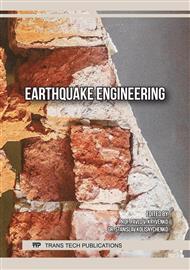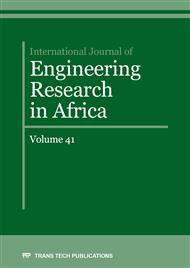[1]
B. A. Olmos, J. M. Jara, M. Jara, Influence of some relevant parameters in the seismic vulnerability of RC bridges, Journal of Earthquakes and Structures.3 (2012) 365-381.
DOI: 10.12989/eas.2012.3.3_4.365
Google Scholar
[2]
C. Zelaschi, R. Monteiro,R.Pinho, Parametric characterization of RC bridges for seismic assessment purposes,J. Structures. 7 (2016)14-24.
DOI: 10.1016/j.istruc.2016.04.003
Google Scholar
[3]
M. A. Zanini, R.Morbin, C. Pellegrino, C.Modena, Influence of relevant parameters on seismic vulnerability assessment of bridges, Proceedings of the 7thInternational Conference on Bridge Maintenance, Safety and Management IABMAS2014, Shanghai, China (2014).
DOI: 10.1201/b17063-350
Google Scholar
[4]
D. Cardone Disgg, Seismic risk assessment of highway bridges. Proceedings of the 1st us–Italy workshop on seismic design and assessment of bridges, Pavia(2007).
Google Scholar
[5]
A. Kibboua, F. Kehila, H. Bechtoula, Y. Mehani, M. Remki, Development of fragility curves for seismic evaluation of a reinforced concrete bridge. Proceedings of the Second European Conference on Earthquake Engineering and Seismology, Istanbul (2014).
DOI: 10.1680/jstbu.19.00142
Google Scholar
[6]
M. C. Djemai, M. Bensaibi, Seismic vulnerability assessment of Tipaza bridges, Proceedings of the 3rd International Conference on Information and Communication Technologies for Disaster Management (ICT-DM), Vienna, Austria (2016).
DOI: 10.1109/ict-dm.2016.7857234
Google Scholar
[7]
J. L. Bignell, J. M. LaFave, N. M. Hawkins, Seismic vulnerability assessment of wall pier supported highway bridges using nonlinear pushover analyses, J. Engineering Structures 27 (2005) 2044–(2063).
DOI: 10.1016/j.engstruct.2005.06.015
Google Scholar
[8]
A. Kibboua, M.Naili, F. Kehila, H.Bechtoula, Y.Mehani, D. Benouar, M.Remki, Seismic vulnerability functions of existingreinforced concrete bridge piers. Proceedings of the 15th World Conference on Earthquake Engineering, Lisbon, Portugal(2012).
DOI: 10.1007/s10518-013-9523-7
Google Scholar
[9]
M. N. Sheikh, A. Vivier, F. Légeron, Seismic assessment of hollow core concrete bridge piers. Proceedings of the 9th Canadian Conference on Earthquake Engineering, Ottawa, Ontario, Canada (2007).
Google Scholar
[10]
A. Yawale, P.S. Lande,Seismic vulnerability assessment of bridge using pushover analysis. International Journal of Engineering Research & Technology(IJERT) 3:2(2014) 2278-0181.
Google Scholar
[11]
P. J. Moss, A. J. Carr,N.Cooke, T. F. Kwai, The influence of bridge geometry on the seismic behavior of bridges on isolating bearings, Bulletin of the NewZealand national society for earthquake engineering, 19: 4 (1986) 255-262.
DOI: 10.5459/bnzsee.19.4.255-262
Google Scholar
[12]
N. Cooke, A. J. Carr, P. J.Moss, T. F. Kwai, The influence of non-geometric factors on the seismic behavior of bridges on isolating bearings, Bulletin of the New Zealand national society for earthquake engineering, 19:4 (1986) 263-271.
DOI: 10.5459/bnzsee.19.4.263-271
Google Scholar
[13]
A. M. Memari, H.G. Harris, A.A. Hamid, A. Scanlon, Seismic Evaluation of Reinforced Concrete Piers in Low to Moderate Seismic Regions, Electron J StructEng 11(2011) 57-68.
DOI: 10.56748/ejse.11143
Google Scholar
[14]
D. R. Vargas, Seismic vulnerability evaluation of RC urban bridges, Proceedings of the14th World Conference on Earthquake Engineering, Beijing, China (2008).
Google Scholar
[15]
N. M. Patel, H. R. Deepa, Analysis, Design and Economic Implications of Tall Pier Bridge and Foundation, International Journal of Science Technology & Engineering (IJSTE), 1:11 (2015) 106 -113.
Google Scholar
[16]
R. Akbari, Seismic fragility analysis of reinforced concrete continuous span bridges with irregular configuration. Structure and Infrastructure Engineering, 8: 9 (2012) 873-889.
DOI: 10.1080/15732471003653017
Google Scholar
[17]
M. M. Tamanani, Y.Gian, A.Ayoub, Design of bridges with unequal pier heights structures, Congress of ASCE, (2014)677- 686.
DOI: 10.1061/9780784413357.061
Google Scholar
[18]
J. C. Sampayo,S. C. Oliveira, Seismic performance of bridges with different pier heights. Longitudinal analysis of an existing bridge, Proceedings of the 9th International Conference on Structural Dynamics, EURODYN 2014, Porto, Portugal, (2014)1323 – 1329.
DOI: 10.17265/1934-7359/2015.06.001
Google Scholar
[19]
D. M. Patel, U. Parekh, Analysis of Tall Pier Bridges. International Journal of Science Technology & Engineering (IJSTE), 2:11 (2016) 255-257.
Google Scholar
[20]
A. J. Kappos, A. G. Sextos, Effect of foundation type and compliance on seismic response of RC bridges, Journal of Bridge Engineering 6:2(2001) 120-130.
DOI: 10.1061/(asce)1084-0702(2001)6:2(120)
Google Scholar
[21]
R. Shafiei-Tehrany, M.ElGawady, W.Coffer, Pushover analysis of I-5 Ravenna bridge, Electronic Journal of Structural Engineering 11:1 (2011) 32 - 41.
DOI: 10.56748/ejse.11141
Google Scholar
[22]
J. E. Padgett, J. Ghosh, L. Duenas-Osorio, Effects of liquefiable soil and bridge modeling parameters on the seismic reliability of critical structural components, Structure and Infrastructure Engineering 9:1(2013) 59 - 77.
DOI: 10.1080/15732479.2010.524654
Google Scholar
[23]
C. C. McDaniel, Seismic assessment and retrofit of existing multi-column bent bridges, The Washington State Department of Transportation, Report No. WA-RD 639.1. (2006).
Google Scholar
[24]
K. Q. Inqualabi, R. K. Garg, K. Balaji Rao Seismic vulnerability of urban bridges due to liquefaction using nonlinear pushover analysis and assessing parameters for damage detection, Proceedings of the 11th International Symposium on Plasticity and Impact Mechanics, IMPLAST 2016, 1739 -1746.
DOI: 10.1016/j.proeng.2016.12.211
Google Scholar
[25]
W. F. Chen, L.Duan, Bridge Engineering Handbook, CRC Press, Boca Raton London New York Washington, D. C.(2000).
Google Scholar



